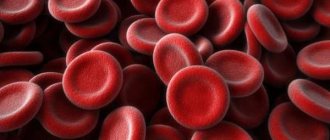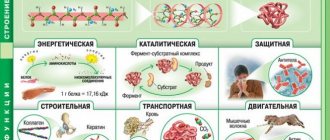Hematocrit is reduced: what does this mean?
Let's start with what is hematocrit?
This is a conditional indicator that is derived by determining the ratio of the number of formed particles - platelets, leukocytes and erythrocytes to the total amount of blood in the venous and arterial vessels.
The overwhelming number of particles are erythrocytes, therefore it is generally accepted that hematocrit (Hst) is an indicator of the number of erythrocytes to the volume of blood (it is calculated in liters).
Now about red blood cells: the duties of these blood particles include delivering oxygen to the blood and removing carbon dioxide from it. A certain (normal) number of them copes with this task. Accordingly, if there are fewer red blood cells, then the hematocrit will be reduced, which means that various pathologies may develop.
For this reason, this topic requires special attention and careful study, since there can be many reasons for the decline. To determine its level, special laboratory tests are prescribed, diagnostics are carried out, using the results of which a diagnosis is made.
How is a blood test performed?
Norm
Before talking about reducing the level of hematocrit in the blood, it is necessary to know the standard values of the indicator, based on the gender and age of the patient.
Hematocrit norms for:
- newborn child – 44–62%;
- child of the first year of life – 36–44%;
- children under ten years of age – 37–44%;
- adult male – 40–52%;
- adult woman – 30–46%.
- Most women have a lower hematocrit during pregnancy - this is a normal consequence of an increase in total blood volume.
Since a low hematocrit level indicates anemia, it is natural that the causes of anemia are the factors that reduce this indicator. All factors that contribute to the development of anemia will also cause a decrease in hematocrit in the blood in adults.
What are normal hematocrit indicators for men and women, as well as children?
To discuss the topic of reduced indicators, you must first understand the normal indicators.
The average Hst level is 0.45 l/liter (450 ml) - this accounts for 40-45 percent of the total blood volume.
But the average percentage differs from the norm for men, women and children, and also depends on their age.
- In children:
- Newborns - 44-62%,
- Grudnichkov - 36-44%,
- From 2 to 5 years – 32-41%,
- From 6 to 11 years – 33-44%.
- In an adult man:
- From 18 to 45 years old – 39-49%,
- After 45 years – 40-50%.
- Among women:
- From 18 to 45 years old - 35-45%,
- After 45 years – 35-47%,
- Separately, for a woman during pregnancy, the hematocrit is usually lower than normal due to an increase in the total amount of blood.
Since low Hst warns of the development of anemia, this means that the factors influencing the occurrence of anemia will influence the decrease in hematocrit.
Normal hematocrit values
| Age | Ht (%) in Women | Ht (%) in Men |
| Blood from the umbilical cord | 42-60 | 42-60 |
| 1-3 days | 45-67 | 45-67 |
| 1 Week | 42-66 | 42-66 |
| 2 weeks | 39-63 | 39-63 |
| 1 month | 31-55 | 31-55 |
| 2 months | 28-42 | 28-42 |
| 3-6 months | 29-41 | 29-41 |
| 6-36 months | 32,5-41,0 | 27,5-41,0 |
| 3-6 years | 31,0-40,5 | 31,0-39,5 |
| 7-12 years | 32,5-41,5 | 32,5-41,5 |
| 13-16 years old | 33,0-43,5 | 34,5-47,5 |
| 17-19 years old | 32,0-43,5 | 35,5-48,5 |
| 20-29 years old | 33,0-44,5 | 38,0-49,0 |
| 30-39 years old | 33,0-44,0 | 38,0-49,0 |
| 40-49 years old | 33,0-45,0 | 38,0-49,0 |
| 50-65 years | 34,0-46,0 | 37,5-49,5 |
| over 65 years | 31,5-45,0 | 30,0-49,5 |
What does a decrease in hematocrit indicate?
Red blood cells are to some extent responsible for the condition of the entire body, since they provide oxygen to each of its cells, and these ellipsoid bodies are also required to take carbon dioxide from the cells.
But if the supply of cells is disrupted (with a decrease in the number of red blood cells and their inability to cope with the task), hypoxia develops, which in turn will lead to a disruption of the acid-base balance and dysfunction of each individual organ.
Its reduced level in the blood causes:
- Fatigue and general malaise,
- Palpitations and tachypnea,
- Headaches and hair loss,
- Marbling of the skin.
These indicators are often reduced if a woman is pregnant, but to confirm the diagnosis of anemia, you need to go for an additional examination and take the appropriate test.
Causes and symptoms of decreased hematocrit levels in adults
Hematocrit decreases as a result of a very large number of reasons, so they are all divided into several groups, which include pathological and physiological, internal and external factors.
Hematocrit does not always fall due to the development of any pathology. Physiological triggers are considered: daily consumption of too much liquid, gestation, starting from 4 months, the postpartum period, menstruation in women, long-term addiction to cigarettes, overeating salt, prolonged fasting, iron deficiency in the body of various etiologies.
A long stay in a horizontal position leads to a drop in hematocrit, an increase in the total volume of circulating blood, and the rapid destruction of red blood cells.
Pathological provocateurs of a decrease in hematocrit in the blood are:
- uncontrolled internal bleeding;
- tumor of any location;
- chronic inflammation;
- anemia (sickle cell);
- hypoproteinemia;
- thalassemia;
- injuries of internal organs, spinal cord;
- fractures;
- multiple myeloma;
- hemoblastosis;
- pathology of the heart, kidneys, liver;
- polycystic disease;
- dysbacteriosis;
- varicose veins of the esophagus;
- leukemia;
- poisoning with cytostatics, hemolytic poisons (toadstools or heavy metals);
- malaria;
- typhoid fever;
- Hodgkin's lymphoma.
A reduced hematocrit is recorded mainly in women and children. Symptoms of the pathology are usually nonspecific. The clinical manifestations of the root cause of the reduced rate come to the fore. Still, there are several symptoms that suggest such a disorder. These are: general weakness, rapid fatigue for no apparent reason, shortness of breath without an organic basis, tachycardia, cephalgia, pale skin, brittle nails and hair.
The essence of the symptoms is tissue hypoxia. Red blood cells deliver oxygen and nutrients to each cell while taking away waste carbon dioxide. A low hematocrit number indicates that the volume of red formed elements per liter of blood becomes less than normal, so oxygen starvation of the cells occurs. At the same time, the acid-base balance is disrupted, which leads to malfunctions of any internal organ.
Causes of low hematocrit
Anemia can develop as a result of a lack of blood cells according to the ml/liter scheme in the following cases:
- During pregnancy (especially in the second half of the term),
- During blood loss, including during menstruation, after injuries, gynecological diseases, fractures and internal bleeding,
- If, on the contrary, the blood volume is increased relative to the number of red blood cells (fluid accumulation or overhydration may be associated with intravenous infusions or infectious infections),
- If the blood is very thin,
- For those who are fasting, on a strict, exhausting diet, or eating poorly,
- As a result of the slow formation of red blood cells and low levels of hemoglobin in the blood,
- With hyperproteinemia (with multiple myeloma),
- With liver dysfunction,
- If you take biological material for analysis from a person who is in a horizontal position, or if a person is seriously ill and is forced to lie down for a long time.
There are a huge number of factors that influence hematocrit levels - even people living at different altitudes relative to sea level will have different HCT values. A large percentage of red blood cells means a person has polycythemia (increased Hst), and if it is very low, then anemia.
What disease can develop with a decrease in indicators:
- Vascular and hepatic pathologies,
- Nephropathy (with polycystic kidney disease, renal artery stenosis, renal failure),
- Anemia (low blood cell levels),
- Chronic inflammatory pathological processes,
- Oncological diseases in the bone marrow area, dangerous tumors (cancer).
All these ailments are very dangerous to human life and health, but they can be avoided if you conduct a timely examination: take a test and determine what exactly affected your body and lowered the level of blood cells.
Low hemoglobin, low hematocrit
How to increase hemoglobin levels?
Regular hemoglobin deficiency for adult men ranges from 14g/dL to 18g/dL. For adult women, this number ranges from 12 g/dL to 16 g/dL. Hemoglobin levels may decrease slightly with age. It can be raised with diet, exercise and medication.
- Eat iron-rich foods to replenish your hemoglobin deficiency. For example, the required amount of iron is contained in 1 cup of ready-made porridge, 85 g of beef, 85 g of canned tuna, and 85 g of liver.
- If you're choosing where to get your iron without using animal products, eat 1 cup kidney beans, 1/2 cup green spinach, 1/2 cup raisins, 12 dried apricots, or 1/2 cup green beans.
- Do not consume iron replacement products. These include caffeinated drinks, chocolate, and foods high in fiber and calcium.
- More training. Studies have shown that moderate to intense aerobic exercise increases hematocrit, or blood cell volume, in professional athletes. Blood cells containing hemoglobin carry oxygen from the lungs to actively working tissues.
- It is recommended to take medications that increase the production of red blood cells. Patients with anemia require erythropoiesis-stimulating drugs. They increase the body's ability to produce more red blood cells. If you are diagnosed with anemia, your doctor may recommend special medications or one of the many erythropoiesis-stimulating drugs available in Russia.
- Get a blood transfusion (there is a risk of getting various diseases from transfusion). But this is only if none of the other suggested methods work.
Until the 1980s, blood transfusions were the only way to increase hemoglobin.
How to increase your hematocrit level?
The hematocrit level is the main way to know how the body is supplied with oxygen.
The more red blood cells present in the body, the more oxygen and nutrients can be delivered to vital organs. A decrease in hematocrit indicates a decrease in oxygen and nutrient consumption.
- Intravenous infusion therapy. In case of blood loss, it is necessary to replace the volume of lost fluid using intravenous infusion therapy. Supplementation of preparations containing iron is required.
- Blood transfusion. During transfusion, the hematocrit level can be increased. A blood transfusion can replace any blood lost in the body.
- A low hematocrit level may be a sign of anemia. Additional iron supplements can help improve the blood's ability to carry and supply oxygen to the body.
- Eliminate the cause of bleeding. Any bleeding, external or internal, should be treated immediately to avoid a decrease in hematocrit levels.
False results
This can happen when blood was taken from a place where the hand was pinched for a long time (for example, with a tourniquet), or the person previously took a drug that thinned the blood. Also, an underestimated level during the analysis will show if infusions were given into a vein or the person was lying down when the fluid was taken from him for analysis.
How is the analysis carried out in a laboratory and the blood gets into the test tube?
Directly on the day of collection, such a test tube is usually already prepared and treated with a substance that prevents the blood from clotting, because otherwise it will not be possible to take an analysis from it.
The sample is sent to the laboratory, where there is a special apparatus in which test tubes are placed and rotated with centrifugal force (centrifugation occurs). After this, the blood is divided: less dense (plasma, the main part of which, 90%, is water, 8% is protein and 2% are hormones) rises to the top, and more dense (white cells or platelets, less than 1% of them, and red blood cells - 45%) - sinks down (settles to the bottom).
And then, during the diagnosis of blood cells, the amount (or percentage) of hematocrit is determined (it is equal to the volume of red cells divided by the total volume of blood).
What level does the hematocrit test show in pregnant women?
As already mentioned, this indicator is lower in pregnant women. This decrease occurs due to a sharp increase in the amount of plasma (up to 33 percent), and this is considered normal for this situation and does not require additional treatment. Because at the end of pregnancy, the HCT indicator will recover and return to normal. But you need to carefully monitor its indicator in pregnant women, since it can manifest itself in the form of iron deficiency anemia, which is associated with overhydration.
Particularly low HCT levels during pregnancy can be observed in the following cases:
- Severe toxicosis,
- Pregnancy of a woman at a very young age,
- Pregnancy with multiple fetuses,
- Repeated pregnancy after a very short period of time,
- Lack of iron in food,
- If a woman was diagnosed with anemia before pregnancy.
Anemia adversely affects a woman, causing bleeding, premature birth and postpartum depression, but even more harms the fetus, since its development can occur with pathologies:
- Born underweight
- Defective (slow) physical development,
- Congenital anemia,
- Pathologies of the nervous system and brain.
It is worth noting that if the mother’s body also has a low level of vitamin B12, then the child may be born with pathologies of the central nervous system.
Who is at risk
A decrease in hematocrit value does not depend on age or gender, but there are categories of people who are most susceptible to this:
- children whose diet is unbalanced;
- children who are developing rapidly;
- women during pregnancy;
- women in the first six weeks after childbirth;
- patients with chronic diseases;
- patients with cardiovascular diseases;
- alcoholics and smokers;
- hereditarily predisposed to cancer.
If a decrease in hematocrit is detected in an infant, it is necessary to conduct a comprehensive examination to clarify the full picture and the presumed diagnosis. The driving factors for a decrease in hematocrit are: slow formation of red blood cells, high rate of their breakdown, increased accumulation of protein in the blood or excessively thin blood.
In an older child, a decrease in hematocrit is observed in most cases due to anemia. What does it mean? First of all, poor nutrition. Due to lack of iron saturation in the blood. A healthy child's menu should include foods rich in iron: meat, eggs, liver, nuts, apples.
During pregnancy, a drop in blood volume is caused by overhydration. This is a failure in the ratio of water and salt, during which tissues and organs are oversaturated with water, due to which blood cells lack oxygen and nutrients.
The postpartum period lasts 6-8 weeks. If there were no complications or illnesses during the entire period of gestation and the birth itself, then during this time all indicators will return to normal.
Chronic diseases act as a catalyst for low hematocrit levels, especially in old age. During the development of the disease, immunity decreases so much that it is unable to produce red blood cells in the bone marrow, significantly reducing their number in the blood.
For smokers and people who abuse alcohol, the root cause of an imbalance of blood cells is difficulty breathing. During shortness of breath, the body compensates for the lack of oxygen entering the lungs with oxygen from blood cells.
A person who has a history of cancer in the family should carefully monitor their health. The percentage of hereditary diseases is too high to be neglected.
What is HCT responsible for in children?
A decrease in hematocrit is possible:
- Due to a decrease in the rate of formation of red blood cells in the bone marrow,
- Due to the increased amount of circulating blood in the arteries and veins,
- For internal and external bleeding,
- Due to an increase in total protein levels,
- As a result of accelerated hemolysis of red blood cells.
Hypoxia - low oxygen content in the body or individual organs and tissues
HCT in children most often indicates the development of anemia, therefore it is necessary to diversify the child’s diet, make it nutritious, since the child will be lethargic, get tired quickly, and he will lose interest in everything.
Normal indicators and increase
Speaking about the HCT norm, we can distinguish the so-called conditionally normal level. In particular, for women it ranges from 35 to 42 percent, for men from 40 to 47 percent. The children's norm should not exceed 44 percent and be below 32. However, you need to understand that such an average figure means that the change in HCT level depends on gender and age.
For men, the norm from adulthood to 45 years is no less than 39 and no more than 49 percent. For the older generation, only the upper limit changes; it should not exceed 50 percent.
However, HCT does not always remain within the normal range; sometimes the interpretation of the analysis indicates an increase in the indicator. There may be several reasons for this:
- prolonged hypoxia;
- dehydration;
- oncological diseases of the blood and kidneys.
When we talk about prolonged hypoxia, we mean a lack of air. We are not talking about suffocation, but about the fact that insufficient oxygen enters the blood. As a result, hemoglobin increases, and the body also begins to increase the number of red blood cells. A general analysis will reveal such an increase in HCT in people suffering from respiratory problems, smokers, mountaineers or tourists who often stay in mountainous areas.
Dehydration is another common cause of increased HCT. Dehydration can often be encountered with peritonitis, infectious diseases, problems with housing and communal services and burns.
Unfortunately, deciphering an analysis with a high hematocrit may be the first step in determining cancer of the blood and kidneys. Increased blood density is a mandatory attribute of leukemia or a tumor in the kidneys. If the transcript leads the doctor to exactly this conclusion, the patient will be prescribed additional studies that will reveal the exact cause of the increase.
Treatment of hematocrit abnormalities
To independently return the indicator to normal, you need to reconsider your diet and start consuming those foods that “know” how to increase hematocrit:
- Iron-fortified foods (eggs, beans, dried fruits, beef liver, greens, red and chicken meat and seafood),
- Foods rich in vitamin C (currants, sea buckthorn, rose hips, cauliflower and red cabbage, broccoli, viburnum, strawberries, tomatoes) - improves the absorption of iron by the body,
- Iron supplements – if the person is also allergic to the above foods or to vitamin C itself.
If the cause of a low hematocrit is anemia, it is necessary to eat foods rich in iron.
Regarding pregnant women, in order to avoid the development of fetal pathologies, a course of iron injections and vitamin complexes is prescribed.











